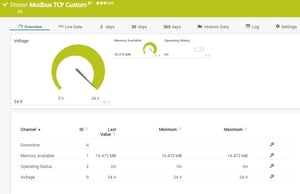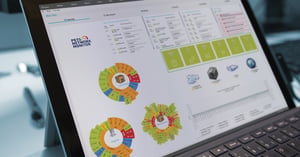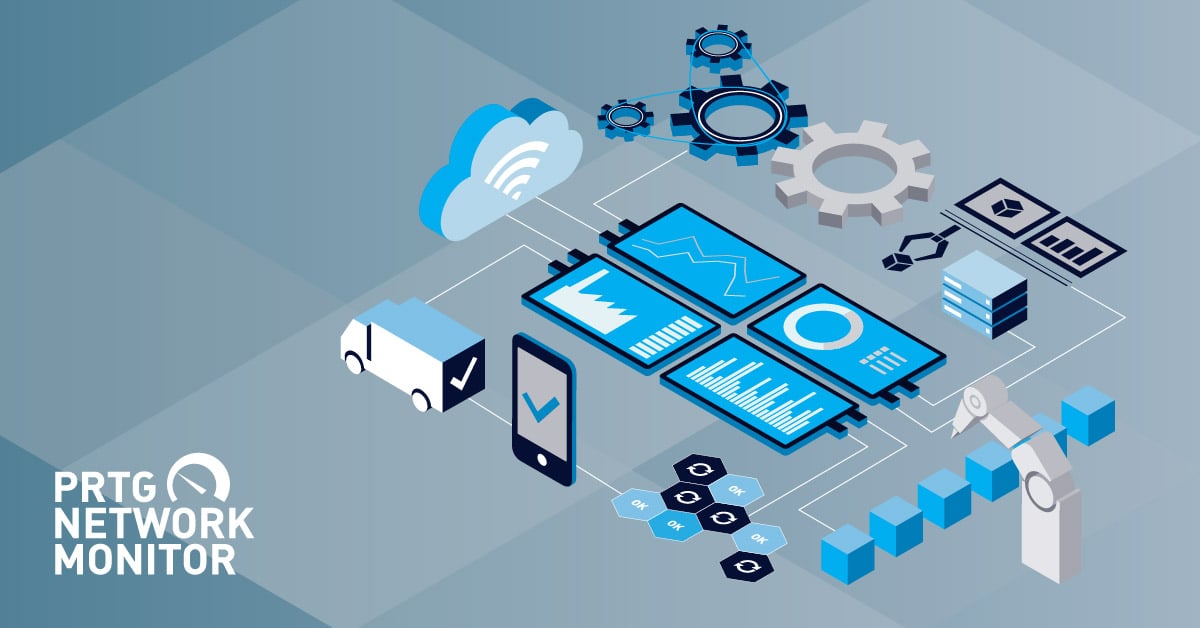In the world of industrial IT, there have traditionally been two kinds of monitoring solutions: those for monitoring the IT aspects, and those for monitoring the Operational Technology (OT) aspects. But convergence in industrial IT — which is bringing IT and OT together — requires a more unified view. And it's this unified view that PRTG Network Monitor can provide with new capabilities for monitoring OT.
PRTG is the perfect holistic monitoring system for your plant due to its powerful IT monitoring, support for several common industrial protocols, and a license that does not limit you regarding the number of users (PRTG is licensed by the number of sensors, or "data collectors" you need).
Watch the video below and read on for a detailed look at just how PRTG is a good fit for industrial IT environments.
IT and OT convergence
IT (servers, routers, switches, and so on) and OT (the automation equipment that controls and executes the production process) have become more connected to each other and to external data collectors in the cloud or in data centers.
This convergence has an impact on monitoring; whereas before it was sufficient to have separate views of OT and IT, now it helps to have a holistic view due to the interconnectedness of systems. This is especially true where there are dependencies between IT and OT. Is the smart industrial gateway up and sending data as it should be? If there is a failure in connectivity, does the problem lie with the machine, the gateway, or somewhere in the ethernet network?
These (and many other questions) are easier to answer if you have a more complete view. This means bringing OT and IT together into a single monitoring concept – something that we’ve written about before. How exactly have we done this with PRTG?
Monitoring the data flow in a factory
PRTG is well-known for its out-of-the-box support for most IT protocols and standards, which help system administrators to monitor their environments. This includes SNMP capabilities, monitoring bandwidth using common methods like Flow protocols or packet sniffing, and getting device metrics using RESTful API. But now this support is being extended into the realm of industrial IT, too, primarily through support for protocols commonly found in OT. Over the past few releases, several options for monitoring OT have been added to PRTG.
Here's an overview of the new functionality for bringing OT data into PRTG.
OPC UA
Open Platform Communication United Architecture, or OPC UA, is a widely-adopted, platform-independent, service-oriented architecture for industrial automation. As more and more manufacturers have adopted the standard, it has become a principle  way for OT devices to connect and communicate with each other, and with external sources.
way for OT devices to connect and communicate with each other, and with external sources.
As of Release 63, PRTG has its first OPC UA sensor (data collector). The OPC UA Server Status sensor can monitor the status, uptime, and diagnostic information of your OPC UA server. And, there is already an alpha version available of an OPC UA custom sensor that you can use to collect data from any device communicating via OPC UA.
MQTT
With the advent of Industrial Internet of Things, more devices than ever are using MQTT, a lightweight, publish-subscribe protocol, to transmit their data. MQTT is particularly useful when it comes to collecting data from large amounts of sensors that track or measure certain data points like temperature, health status or object motion.
Also, smart industrial gateways, which collect data from OT devices and systems, often send information to external data targets (like the cloud or data centers) using MQTT. This makes MQTT a valuable piece in the puzzle of connecting OT and IT. Just as an example, you can consider how PRTG can be used to get data from an INSYS icom smart gateway.
PRTG offers three new sensors for monitoring MQTT data:
- MQTT Subscribe Sensor - subscribe to a specific topic to bring in data sent by devices about that topic, and send out MQTT-based notifications
- MQTT Statistics Sensor - track statistics such as the volume of MQTT messages being broadcast by the MQTT broker about different topics.
- MQTT Roundtrip Sensor - ensure that MQTT devices are up and available for communication.
Modbus TCP
 The Modbus TCP protocol has a large installed base, and is used by a great variety of devices in the industrial, energy, and building-automation spaces. PRTG now offers a Modbus TCP sensor, which means that it can access the data of this equipment. For example: PRTG can use the Modbus TCP sensor to monitor cooling units, power supplies, or backup generators.
The Modbus TCP protocol has a large installed base, and is used by a great variety of devices in the industrial, energy, and building-automation spaces. PRTG now offers a Modbus TCP sensor, which means that it can access the data of this equipment. For example: PRTG can use the Modbus TCP sensor to monitor cooling units, power supplies, or backup generators.
Soffico Orchestra
Soffico Orchestra is used in industrial technology to manage and automate manufacturing processes. PRTG introduces a Soffico Orchestra Channel Health sensor that monitors the status of Soffico Orchestra, and shows the number of successful and failed channel calls.
These sensors are just the start. We are also planning to introduce support for more manufacturers and devices on the factory floor in the future.
Bringing the information into one view
 Something that PRTG has always done well is create a unified overview of an entire infrastructure. Now, with new support for industrial IT devices and protocols, PRTG offers out-of-the-box functionality for bringing OT monitoring into your IT monitoring concept without the cost and complexity of a SCADA system.
Something that PRTG has always done well is create a unified overview of an entire infrastructure. Now, with new support for industrial IT devices and protocols, PRTG offers out-of-the-box functionality for bringing OT monitoring into your IT monitoring concept without the cost and complexity of a SCADA system.
In addition to this, the benefits that come with a monitoring solution, such as setting thresholds, defining alerts and notifications, and using monitoring data to predict potential failures, all give you better control and sight of both your traditional IT and selected factory processes in one place.
For some examples of how to use PRTG to monitor industrial IT, here are three use cases. If you want to learn more about PRTG and test out its industrial IT sensors, click the banner below.
 Published by
Published by 












